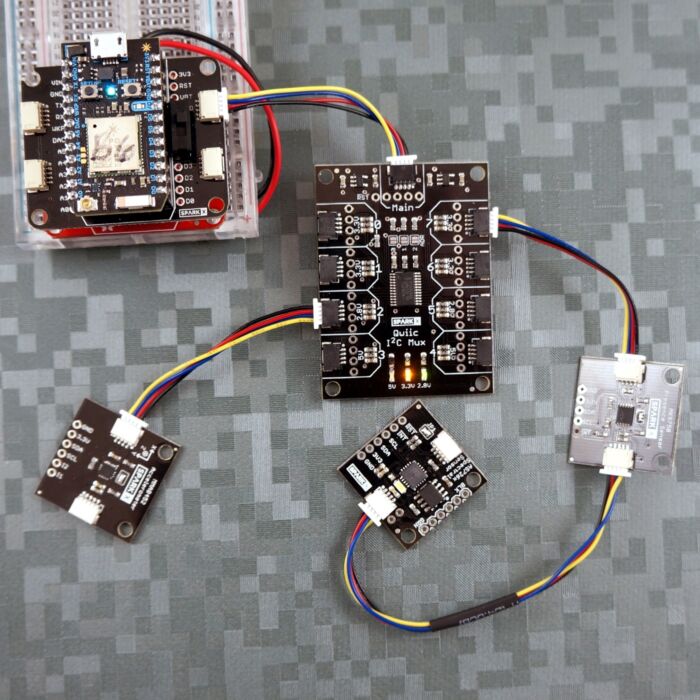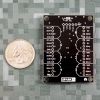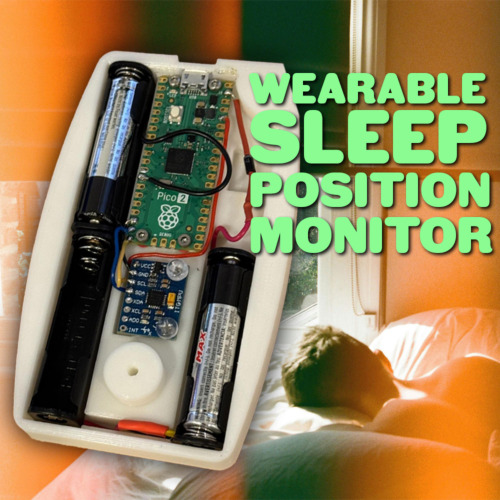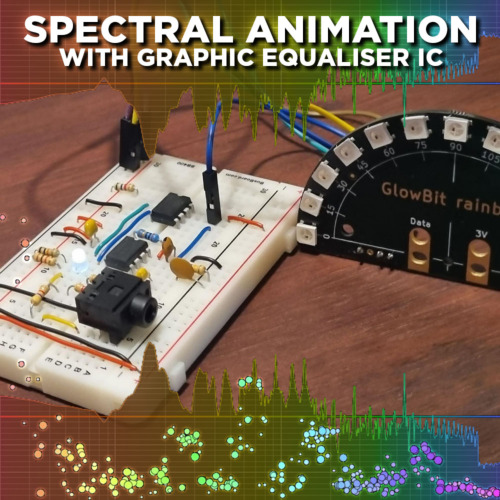The Qwiic Mux - PCA9548A enables communication with multiple I2C devices that have the same address and between different bus voltages (2.8V, 3.3V, and 5V). The PCA9548A is a very easy to use I2C multiplexer enabling up to 8 buses. This means you can communicate with 8 of the same device or mix and match between 5V, 3.3V and 2.8V devices. The PCA9548A can be daisy chained as well, so, if needed, you can use up to eight of the shields at the same time enabling a whopping 64 buses.
Some I2C devices have a selectable address, but many have only one. The Qwiic Mux allows control of multiple haptic drivers, multiple accelerometers, or finger sensors with ease.
We took all the good things from the Arduino Mux Shield and added a scoop of features on top. The Qwiic Mux includes two regulators so the master can operate and power the board at 5V or 3.3V and a regulated 3.3V and 2.8V will be generated for the appropriate buses. A jumper on the rear of the board controls the main bus voltage. Three power LEDs indicate which power rails are active. All 8 buses now have ample decoupling and are broken out to both Qwiic connectors and 0.1" footprints.
How do I use the Qwiic Mux? Connect your platform of choice (Arduino, Photon, Raspberry Pi, etc) to the Main connector over I2C. Connect your device to either the 2.8V, 3.3V, or 5V bus. As you can see from the photo, Qwiic cables make this easy but you can solder male headers or wires to each port as well.
How do I control the PCA9548A? It’s surprisingly easy. Over I2C, you tell the device which port you want to talk to, for example port 3. After that, whatever I2C traffic happens gets sent to port 3. By switching back and forth between ports, it’s easy to talk to multiple devices that have the same address!
What is the difference between the PCA9548A and TCA9548A? Very little. PCA is made by NXP, TCA is made by TI. PCA can operate from 2.3 to 5.5V, TCA can operate from 1.65 to 5.5V. Everything else is identical.
Issues with this version: SparkX moves fast and we’d rather get something into the wild then let it languish in the lab. The top silkscreen is correct but the rear silkscreen incorrectly identifies ports 0, 1, and 2 as 5V. Ports 0 and 1 are 3.3V, Port 2 is 2.8V.
The Qwiic system enables fast and solderless connection between popular platforms and various sensors and actuators. You can read more about the Qwiic system here. We carry 200mm, 100mm, 50mm, and breadboard friendly Qwiic cables.
We do not plan to regularly produce SparkX products so get them while they’re hot!
Features:
- Works with popular platforms including Arduino, Photon, Raspberry Pi, Tessel 2, ESP32/ESP8266, and Edison
- 9 ports with Qwiic connectors and 0.1" footprints
- Four 3.3V buses, two 2.8V buses, two 5V buses
- On board 3.3V (600mA) and 2.8V (150mA) regulation
- Bus power indicator LEDs
- Pull-up resistors and decoupling caps provided on all buses
- Address jumpers to enable up to eight shields operating at the same time
Documents:
- Schematic
- Eagle Files
- PCA9548A Datasheet, TCA9548A Datasheet
- Arduino example sketches showing how to talk to two MMA8452Q accelerometers simultaneously
- To get the latest files please visit the GitHub repo
Exact shipping can be calculated on the view cart page (no login required).
Products that weigh more than 0.5 KG may cost more than what's shown (for example, test equipment, machines, >500mL liquids, etc).
We deliver Australia-wide with these options (depends on the final destination - you can get a quote on the view cart page):
- $3+ for Stamped Mail (typically 10+ business days, not tracked, only available on selected small items)
- $7+ for Standard Post (typically 6+ business days, tracked)
- $11+ for Express Post (typically 2+ business days, tracked)
- Pickup - Free! Only available to customers who live in the Newcastle region (must order online and only pickup after we email to notify you the order is ready). Orders placed after 2PM may not be ready until the following business day.
Non-metro addresses in WA, NT, SA & TAS can take 2+ days in addition to the above information.
Some batteries (such as LiPo) can't be shipped by Air. During checkout, Express Post and International Methods will not be an option if you have that type of battery in your shopping cart.
International Orders - the following rates are for New Zealand and will vary for other countries:
- $12+ for Pack and Track (3+ days, tracked)
- $16+ for Express International (2-5 days, tracked)
If you order lots of gear, the postage amount will increase based on the weight of your order.
Our physical address (here's a PDF which includes other key business details):
40 Aruma Place
Cardiff
NSW, 2285
Australia
Take a look at our customer service page if you have other questions such as "do we do purchase orders" (yes!) or "are prices GST inclusive" (yes they are!). We're here to help - get in touch with us to talk shop.
Have a product question? We're here to help!
Guides
The Maker Revolution
Projects
The Skeg Flexer - A Surfboard Fin Test Jig
The Snooze Logger - A Wearable Sleep Position Monitor
Spectral Animations with a DIY MSGEQ7 I2C Device
Makers love reviews as much as you do, please follow this link to review the products you have purchased.









Product Comments